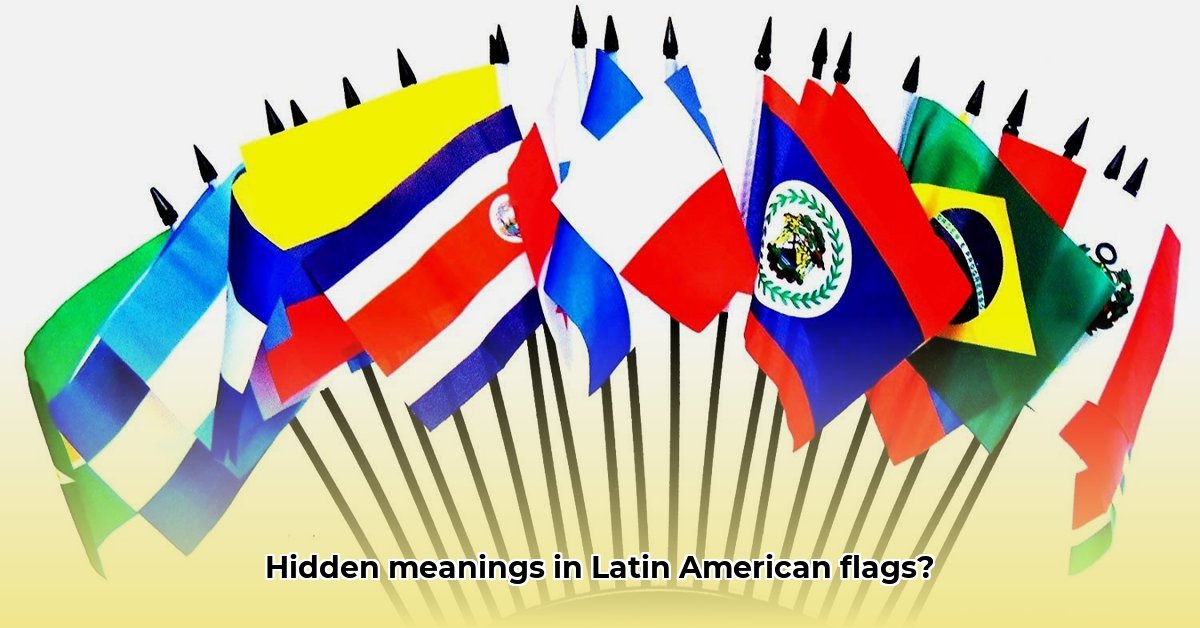What stories do the flags of Latin America tell? More than just colorful emblems, these flags are rich tapestries woven with the threads of history, culture, and national identity. For a glimpse into ancient symbolism, check out this link on ancient artifacts. From the bold reds of revolution to the golden suns of ancient empires, each flag offers a unique narrative, reflecting the triumphs and struggles of a nation. This exploration unpacks the hidden secrets within these vibrant designs, examining common symbols and surprising differences that highlight the region’s diverse heritage. Discover how a simple flag can reveal centuries of resilience, innovation, and the enduring quest for national identity.
The Flags of Latin America: A Colorful Journey Through History and Identity
The flags of Latin America serve as more than mere emblems; they are visual representations of each nation’s unique journey. While sharing some common visual elements, a closer look reveals a fascinating range of individual interpretations and meanings. Delve into the rich symbolism that makes these flags so captivating.
A Symphony of Colors: Decoding the Hues
The colors in Latin American flags are far from arbitrary; they carry deep symbolic weight. Red frequently signifies the blood shed during the fight for independence, representing revolution and sacrifice. Blue often evokes the skies and oceans, symbolizing freedom, hope, or the boundless potential of the continent. Yellow or gold typically represents the sun, a source of life and energy, and the country’s natural resources and wealth. However, these meanings are not universal. While red often represents revolution, it may also relate to specific historical events or significant figures within a particular nation, adding layers of complexity. For example, in Argentina and Uruguay, the color blue on their flags is believed to be inspired by the sky on the day the May Revolution began, marking the start of their independence movements.
Shared Symbols, Unique Stories: Eagles, Suns, and Stars Revisited
Beyond color, many Latin American flags share common imagery, adding another layer to their stories. The eagle, a symbol of strength, power, and national pride, appears on several flags. However, its depiction—posture, surroundings—varies significantly, reflecting unique national narratives. The Mexican flag features an eagle devouring a serpent on a cactus, a central image from the Aztec legend of the founding of Tenochtitlan (now Mexico City), symbolizing the triumph of good over evil and the nation’s ancient heritage.
Stars are another frequently encountered symbol, representing states, principles, or aspirations such as liberty and unity. The number of stars, their arrangement, and their context within the flag’s design vary widely. In the Venezuelan flag, the stars originally represented the provinces that declared independence from Spain. The Chilean flag’s single star represents the country as a unitary state.
The sun often signifies life, vitality, power, and national identity. Different depictions of the sun—the Incan sun (as seen on the Argentinian and Uruguayan flags), for example—hint at a nation’s indigenous roots and historical heritage. The “Sun of May” depicted on these flags commemorates the May Revolution and symbolizes the Incan sun god, Inti.
Coats of arms represent visual records of a nation’s history, embodying its heritage and often encapsulating significant events and cultural symbols. The coat of Arms of Costa Rica, for example, depicts three volcanoes, symbolizing the country’s three main mountain ranges, as well as ships representing the nation’s maritime history and trade.
| Symbol | Common Interpretations | Examples | Unique Interpretations and Variations |
|---|---|---|---|
| Eagle | Strength, national pride, power, vigilance | Mexico, Guatemala, Ecuador | Variations in style, pose, and surrounding elements reveal diverse cultural interpretations. The specific imagery often ties into national legends and foundation myths. |
| Sun | Life, energy, national identity, sovereignty | Argentina, Uruguay, Bolivia | Different styles – Incan sun, Aztec sun, representing distinct pre-Columbian cultures. The context of the sun within the flag design also affects its specific meaning. |
| Stars | States, ideals, unity, hope, guidance | Venezuela, Chile, Brazil | Number, arrangement, and size reflect historical events and regional composition. In Brazil, each star represents a different state. |
| Coats of Arms | National identity, historical significance, emblem | Most Latin American countries | Reflects unique national histories, events, and cultural legacies, showing remarkable variations. These emblems can incorporate diverse symbols representing different aspects of the nation’s character. |
Echoes of the Past: Colonialism, Independence, and Indigenous Influences in Flag Design
The history of Latin American flags is intertwined with colonialism, independence movements, and enduring indigenous influences. The colonial period left its mark, with many flags initially incorporating colors and symbols derived from their European colonizers. The fight for independence brought about new colors and symbols, often representing newly won freedom and national identity. Simultaneously, pre-Columbian designs and symbols honor indigenous cultures, reflecting their influence on the formation of national identities.
Case Studies: Stories Woven into Fabric
Consider the flag of Bolivia, which incorporates the Wiphala, a square emblem representing the indigenous peoples of the Andes. This inclusion acknowledges the significance of Bolivia’s indigenous heritage and reflects a commitment to inclusivity. Or examine the flag of Paraguay, which is unique in that it has different emblems on its obverse and reverse sides. The obverse displays the national coat of arms, while the reverse features the Treasury Seal, a golden lion in front of a staff and Phrygian cap, symbolizing liberty.
The Ever-Evolving Narrative: Change and Continuity in Latin American Flags
Latin American flags are not static objects but dynamic symbols that have evolved alongside their nations. Political revolutions, shifts in national identity, and changing understandings of national symbols have led to modifications and alterations to flags. These changes demonstrate the living nature of national identity, highlighting that these flags are not just symbols but ongoing narratives that are constantly being written, rewritten, and interpreted. In 1960, the number of stars on the Flag of Venezuela was changed to seven to represent the seven provinces that signed the Declaration of Independence. Later, an eighth star was added to honor Simón Bolívar. The ongoing study of these changes provides valuable insights into the evolving cultural and political landscape of Latin America.
Unveiling the Secrets: Interpreting Symbolism in Latin American Flags
To fully appreciate the flags of Latin America, consider these key factors:
- Analyze the colors used and their traditional or historical associations.
- Identify recurring symbols (eagles, suns, stars) and consider their specific cultural significance within each nation.
- Research the history of each flag, looking for connections to colonialism, independence movements, and indigenous heritage.
- Examine the coat of arms or other emblems present on the flag and understand their component parts.
- Be aware that flag designs and symbolism can evolve over time, reflecting changes in national identity and political landscapes.
Decoding the Colors: A Palette of Patriotism
Many flags across Latin America share similar color schemes, carrying powerful symbolic meanings. Red often represents the blood shed for independence, while blue frequently symbolizes the skies or oceans, representing liberty and freedom. Yellow or gold, associated with mineral wealth or the sun, represents prosperity and national strength. Green, present in flags such as Mexico’s, often represents hope, fertility, and agricultural wealth. Remember that these are common interpretations; the actual meaning can vary depending on the specific nation.
Shared Symbols, Unique Stories: Emblems of Nationhood
Eagles, suns, and stars appear on many Latin American flags, but their significance varies considerably. An eagle symbolizes strength and sovereignty in one country, while in another it represents a specific historical figure or national myth. The Mexican eagle, for instance, is a direct reference to the Aztec founding myth. The sun, often connected to the rising of a new nation or indigenous sun gods, takes on different nuances within each nation’s narrative.
History’s Hand: The Shaping of National Identity through Flag Design
The flags of Latin America have evolved, mirroring the political and social changes within each country. Colonialism’s impact reverberates through many national symbols. The fight for independence left an indelible mark, with flags incorporating elements designed to celebrate freedom from colonial rule. Indigenous influences are also keenly felt, adding another layer of meaning to colors and emblems. These factors are crucial when learning how to interpret symbolism in Latin American flags.
Case Study: A Deeper Dive into Gran Colombia
The flags of Venezuela, Colombia, and Ecuador, countries that were once part of Gran Colombia, share striking similarities. These nations retain the yellow, blue, and red tricolor, a design choice inspired by Francisco de Miranda, a Venezuelan revolutionary. This shared heritage demonstrates the lasting impact of historical political structures, making it a compelling example of how to interpret symbolism in Latin American flags beyond identifying individual elements.
Latin American Flag Designs: A Regional Comparative Analysis of Symbolism and Evolution
Latin American flags, though diverse, share common threads reflecting independence struggles and a rich cultural heritage. Understanding these connections requires examining color symbolism, shared symbols, and historical influences.
Colors: Symbolism across Latin American Flags
Red often symbolizes the blood shed for independence, while blue is frequently associated with liberty and the sky or ocean. Yellow/gold typically represents wealth, resources, or the sun, while green, when present, often symbolizes hope or agricultural prosperity. However, the specific interpretation can vary slightly from country to country. For example, in some Central American countries, blue is meant to represent the two bodies of water that border it, the Pacific Ocean and the Caribbean Sea.
Common Symbols: Eagles, Stars, and Suns
Eagles symbolize strength and national
















